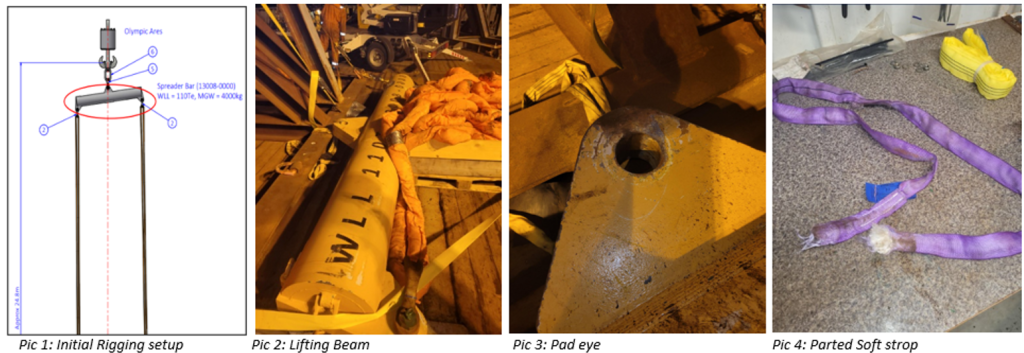Dropped lifting beam due to parted soft strop
What happened?
During lifting operations a lifting beam weighing 4 Te was dropped from 50cm. The incident occurred when the lifting beam was being prepared for relocation for sea fastening prior to transit. A 1 Te strop was doubled through the main lifting pad eye on the lifting beam for the relocation. When the crane started lifting the beam, the soft strop parted, and the beam fell 50cm to deck. The deck crew kept a safe distance from the lift; no-one was injured.

What went wrong
- The weight of the lifting beam was not checked before the relocation;
- An unidentified sharp edge on the pad eye in combination with an 1 Te soft strop (lifting a beam weighing 4 Te) caused the soft strop to part.
Our member considered that owing to the nature of the unidentified sharp edge on the pad eye, it is likely that even a higher rated soft strop would have also been severed in this operation.
What was the cause
- Our member identified as the cause, a failure to properly assess and identify risk.
Actions taken
- Never use soft strops against straight / sharp edges;
- Any straight or sharp edges or corners identified should be protected or covered or alternate lifting arrangements identified;
- Verify the weight of objects before the lift. Always verify that lifting equipment has the capacity to lift the load in hand;
- Be ready to STOP THE JOB if you are unsure about the safest method to be used.
Members may wish to refer to:
- Failure of webbing strop during lifting operations
- Failure of slings during loading operations
- Failure of lifting equipment: Dropped ROV
- High potential near-miss – Lifting equipment failure
- IMCA LR009 – Guidance on the selection, safe use and inspection of high performance fibre slings used for engineered lifts
Safety Event
Published: 3 June 2024
Download: IMCA SF 11/24
IMCA Safety Flashes
Submit a Report
IMCA Safety Flashes summarise key safety matters and incidents, allowing lessons to be more easily learnt for the benefit of all. The effectiveness of the IMCA Safety Flash system depends on Members sharing information and so avoiding repeat incidents. Please consider adding [email protected] to your internal distribution list for safety alerts or manually submitting information on incidents you consider may be relevant. All information is anonymised or sanitised, as appropriate.
IMCA’s store terms and conditions (https://www.imca-int.com/legal-notices/terms/) apply to all downloads from IMCA’s website, including this document.
IMCA makes every effort to ensure the accuracy and reliability of the data contained in the documents it publishes, but IMCA shall not be liable for any guidance and/or recommendation and/or statement herein contained. The information contained in this document does not fulfil or replace any individual’s or Member's legal, regulatory or other duties or obligations in respect of their operations. Individuals and Members remain solely responsible for the safe, lawful and proper conduct of their operations.
